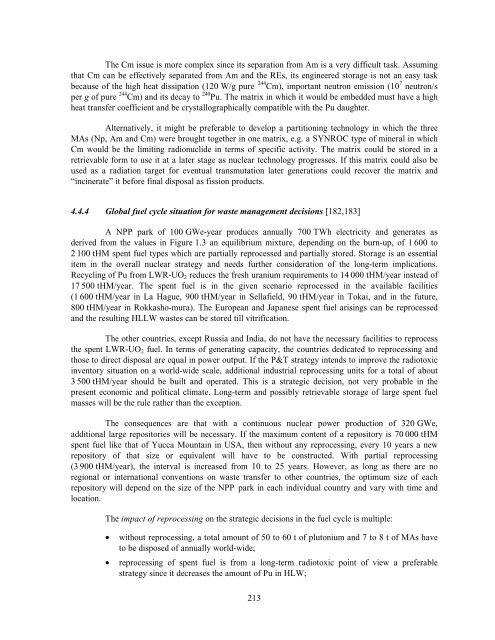COMPLETE DOCUMENT (1862 kb) - OECD Nuclear Energy Agency
COMPLETE DOCUMENT (1862 kb) - OECD Nuclear Energy Agency
COMPLETE DOCUMENT (1862 kb) - OECD Nuclear Energy Agency
You also want an ePaper? Increase the reach of your titles
YUMPU automatically turns print PDFs into web optimized ePapers that Google loves.
The Cm issue is more complex since its separation from Am is a very difficult task. Assuming<br />
that Cm can be effectively separated from Am and the REs, its engineered storage is not an easy task<br />
because of the high heat dissipation (120 W/g pure 244 Cm), important neutron emission (10 7 neutron/s<br />
per g of pure 244 Cm) and its decay to 240 Pu. The matrix in which it would be embedded must have a high<br />
heat transfer coefficient and be crystallographically compatible with the Pu daughter.<br />
Alternatively, it might be preferable to develop a partitioning technology in which the three<br />
MAs (Np, Am and Cm) were brought together in one matrix, e.g. a SYNROC type of mineral in which<br />
Cm would be the limiting radionuclide in terms of specific activity. The matrix could be stored in a<br />
retrievable form to use it at a later stage as nuclear technology progresses. If this matrix could also be<br />
used as a radiation target for eventual transmutation later generations could recover the matrix and<br />
“incinerate” it before final disposal as fission products.<br />
4.4.4 Global fuel cycle situation for waste management decisions [182,183]<br />
A NPP park of 100 GWe-year produces annually 700 TWh electricity and generates as<br />
derived from the values in Figure 1.3 an equilibrium mixture, depending on the burn-up, of 1 600 to<br />
2 100 tHM spent fuel types which are partially reprocessed and partially stored. Storage is an essential<br />
item in the overall nuclear strategy and needs further consideration of the long-term implications.<br />
Recycling of Pu from LWR-UO 2 reduces the fresh uranium requirements to 14 000 tHM/year instead of<br />
17 500 tHM/year. The spent fuel is in the given scenario reprocessed in the available facilities<br />
(1 600 tHM/year in La Hague, 900 tHM/year in Sellafield, 90 tHM/year in Tokai, and in the future,<br />
800 tHM/year in Rokkasho-mura). The European and Japanese spent fuel arisings can be reprocessed<br />
and the resulting HLLW wastes can be stored till vitrification.<br />
The other countries, except Russia and India, do not have the necessary facilities to reprocess<br />
the spent LWR-UO 2 fuel. In terms of generating capacity, the countries dedicated to reprocessing and<br />
those to direct disposal are equal in power output. If the P&T strategy intends to improve the radiotoxic<br />
inventory situation on a world-wide scale, additional industrial reprocessing units for a total of about<br />
3 500 tHM/year should be built and operated. This is a strategic decision, not very probable in the<br />
present economic and political climate. Long-term and possibly retrievable storage of large spent fuel<br />
masses will be the rule rather than the exception.<br />
The consequences are that with a continuous nuclear power production of 320 GWe,<br />
additional large repositories will be necessary. If the maximum content of a repository is 70 000 tHM<br />
spent fuel like that of Yucca Mountain in USA, then without any reprocessing, every 10 years a new<br />
repository of that size or equivalent will have to be constructed. With partial reprocessing<br />
(3 900 tHM/year), the interval is increased from 10 to 25 years. However, as long as there are no<br />
regional or international conventions on waste transfer to other countries, the optimum size of each<br />
repository will depend on the size of the NPP park in each individual country and vary with time and<br />
location.<br />
The impact of reprocessing on the strategic decisions in the fuel cycle is multiple:<br />
• without reprocessing, a total amount of 50 to 60 t of plutonium and 7 to 8 t of MAs have<br />
to be disposed of annually world-wide;<br />
• reprocessing of spent fuel is from a long-term radiotoxic point of view a preferable<br />
strategy since it decreases the amount of Pu in HLW;<br />
213
















